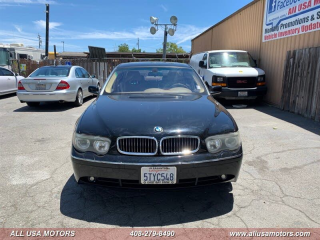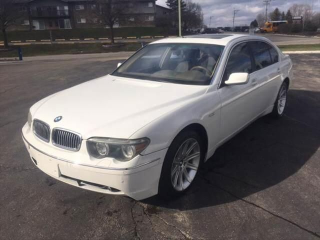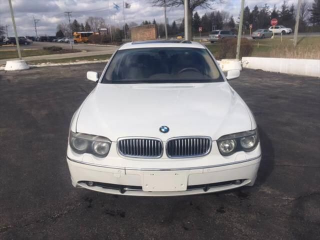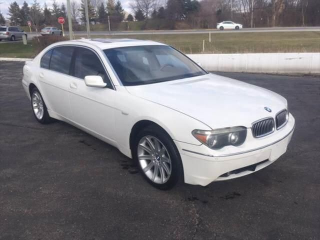The 2003 BMW 7-Series, part of the E65 (standard wheelbase) and E66 (long wheelbase) generation, marked a radical departure for BMW, running from 2002-2008. It's a full-size luxury sedan, primarily available as the 745i/Li and the range-topping 760i/Li. Its bold "Bangle Butt" design and the revolutionary iDrive infotainment system made it highly controversial yet distinctive, standing out with its technological ambition and powerful V8/V12 engines.
The Good
Emotionally, the 2003 7-Series offers potent V8/V12 performance, refined handling for its size, and a commanding presence. Practically, it boasts a spacious, luxurious cabin with advanced features for its era. Despite initial design controversies, its distinctive styling sets it apart. While not known for efficiency, its depreciated value offers access to high-end luxury.
The Bad
Key weaknesses include its complex and often problematic iDrive system, high maintenance and repair costs, especially for electrical components and V8 engine's valve stem seals. The ride can be firm with larger wheels, and reliability issues, particularly with electronics and the transmission, are common concerns that require careful attention.
2003 BMW 7-Series: Quick Overview
- Engine Options:
- 745i/745Li: 4.4L N62B44 V8 engine.
- 760i/760Li: 6.0L N73B60 V12 engine.
- Horsepower:
- 745i/745Li: 325 hp @ 6100 rpm and 330 lb-ft of torque @ 3600 rpm.
- 760i/760Li: 438 hp @ 6000 rpm and 444 lb-ft of torque @ 3500 rpm.
- Fuel Economy (EPA estimates):
- 745i/745Li: Approximately 18 MPG combined (15 MPG city/23 MPG highway).
- 760i/760Li: Approximately 16 MPG combined (13 MPG city/20 MPG highway).
- 0-60 MPH Times (approximate):
- 745i/745Li: Around 5.9-6.0 seconds.
- 760i/760Li: Around 5.3-5.4 seconds.
- Towing Capacity: The 7-Series is not typically rated for significant towing in the U.S. market; it's not designed for this purpose. BMW advises against towing.
- Trim-Level Features (Standard for 2003 745i/Li, with 760i/Li adding more):
- Standard Equipment: Leather upholstery, dual-zone automatic climate control, 10-way power-adjustable front seats, power tilt-and-telescoping steering wheel, power windows/locks/mirrors, self-leveling rear suspension.
- iDrive System: Central control knob and screen for navigation, climate, audio, and communication.
- Audio System: Premium AM/FM/CD audio system, typically with 10 speakers.
- Safety: Front, side, and head curtain airbags; ABS (Anti-lock Braking System); DSC (Dynamic Stability Control); DTC (Dynamic Traction Control).
- Exterior: Xenon adaptive headlights, power moonroof, 18-inch alloy wheels (19-inch optional).
- 760i/Li Additions: V12 engine, Logic 7 premium sound system, upgraded leather, heated front and rear seats, extended wood trim, power rear sunshade, automatic soft-close doors, and more advanced active suspension components like Dynamic Drive.
- Optional Features: Active Cruise Control, Logic 7 sound system (for 745i/Li), heated steering wheel, cooled seats, rear seat entertainment, active front seats, park distance control.
2003 BMW 7-Series Specifications
Vehicle Information
| Year | 2003 |
| Make | BMW |
| Model | 7-Series |
| Trim | - |
| Style | 4-Door Sedan |
| Type | Sedan |
| Category | Mid-Size Car |
Manufacturing Details
| Made In | Germany |
| Manufacturing City | DINGOLFING |
Dimensions
| Doors | 4-Door |
| Curb Weight | 4376 pounds |
| Gross Vehicle Weight Rating | 6000 pounds |
| Overall Height | 58.70 inches |
| Overall Length | 198.00 inches |
| Overall Width | 74.90 inches |
| Wheelbase Length | 117.70 inches |
| Standard Seating | 5 |
Engine & Performance
| Engine | 4.4-L V-8 |
| Engine Size | 4.4L |
| Engine Cylinders | 8 |
| Transmission | 6-Speed Automatic |
| Transmission Type | Automatic |
| Transmission Speeds | 6-Speed |
| Drivetrain | Rear-Wheel Drive |
Additional Features
| Anti-Brake System | 4-Wheel ABS |
| Steering Type | Rack & Pinion |
Pricing
| Manufacturer Suggested Retail Price (MSRP) | $68,500 |
| Invoice Price | $62,495 |
| Delivery Charges | $695 |
Vehicle History Report
Vehicle
Specifications
Specifications
Ownership
History
History
All History
Events
Events
NMVTIS Title
History Check
History Check
Salvage/Rebuilt
Check
Check
Accident
Check
Check
Theft
Check
Check
Open Lien
Check
Check
Past Sale
Listings
Listings
Safety
Recalls
Recalls
Odometer
Check
Check
Market Price
Analysis
Analysis
What Problems Does the 2003 BMW 7-Series Have?
The 2003 BMW 7-Series (E65/E66) is known for several significant long-term reliability concerns, primarily due to its advanced and complex electronics. The most frequently reported problem is with the iDrive infotainment system, which can suffer from software glitches, freezing, and hardware failures, leading to loss of control over essential vehicle functions.
Electrical system issues are rampant, including sensor failures (e.g., crank position sensor, camshaft position sensor), battery drain problems, and malfunctions in various control modules (e.g., body control module, light control module). Window regulators are also a common point of failure.
The N62 V8 engine, found in the 745i/Li, is notorious for valve stem seal leaks, which cause excessive oil consumption and visible blue smoke from the exhaust, especially on startup or after idling. This repair is labor-intensive and expensive. Other engine-related issues include leaks from the alternator bracket gasket and coolant leaks from the valley pan gasket and coolant transfer pipe, often leading to engine overheating if not addressed promptly.
Transmission problems, particularly related to the ZF 6-speed automatic, can occur, often manifesting as harsh shifts, slipping, or complete failure. These are frequently traced back to the mechatronics unit or valve body.
The advanced suspension systems can also be problematic. Dynamic Drive (active anti-roll bars) can develop leaks or motor failures, and the electronic damper control (EDC) or air suspension components (especially on long-wheelbase Li models) can fail, leading to an uneven ride height or poor ride quality.
Recalls for the 2003 model year included issues such as potential problems with the Daytime Running Lights (DRL) which could cause the low beam headlights to turn off unexpectedly (NHTSA Campaign 03V001000) and certain models having issues with driver's side front airbag inflator where the airbag could rupture (NHTSA Campaign 15V046000 and subsequent related recalls for Takata airbags). Another recall concerned potential for the fuel pump to cease functioning (NHTSA Campaign 05V090000). These issues highlight the complexity and potential for costly repairs in older luxury vehicles like the E65 7-Series.
Electrical system issues are rampant, including sensor failures (e.g., crank position sensor, camshaft position sensor), battery drain problems, and malfunctions in various control modules (e.g., body control module, light control module). Window regulators are also a common point of failure.
The N62 V8 engine, found in the 745i/Li, is notorious for valve stem seal leaks, which cause excessive oil consumption and visible blue smoke from the exhaust, especially on startup or after idling. This repair is labor-intensive and expensive. Other engine-related issues include leaks from the alternator bracket gasket and coolant leaks from the valley pan gasket and coolant transfer pipe, often leading to engine overheating if not addressed promptly.
Transmission problems, particularly related to the ZF 6-speed automatic, can occur, often manifesting as harsh shifts, slipping, or complete failure. These are frequently traced back to the mechatronics unit or valve body.
The advanced suspension systems can also be problematic. Dynamic Drive (active anti-roll bars) can develop leaks or motor failures, and the electronic damper control (EDC) or air suspension components (especially on long-wheelbase Li models) can fail, leading to an uneven ride height or poor ride quality.
Recalls for the 2003 model year included issues such as potential problems with the Daytime Running Lights (DRL) which could cause the low beam headlights to turn off unexpectedly (NHTSA Campaign 03V001000) and certain models having issues with driver's side front airbag inflator where the airbag could rupture (NHTSA Campaign 15V046000 and subsequent related recalls for Takata airbags). Another recall concerned potential for the fuel pump to cease functioning (NHTSA Campaign 05V090000). These issues highlight the complexity and potential for costly repairs in older luxury vehicles like the E65 7-Series.
How long will the 2003 BMW 7-Series last?
With meticulous and proactive maintenance, a 2003 BMW 7-Series can comfortably reach 150,000 to 200,000 miles or more, potentially offering 15-20 years of service. However, this longevity is heavily contingent on diligent upkeep, using BMW-specific parts and fluids, and addressing issues as they arise, rather than deferring repairs. Neglect quickly leads to cascading failures, especially in the complex electrical and cooling systems. The V8's valve stem seals are a known durability weakness, often requiring attention around the 100,000-mile mark. Electronic modules and suspension components are also prone to wear and failure over time, becoming costly propositions as the vehicle ages.
What Technology & Safety Features are Included?
The 2003 BMW 7-Series was a technological showcase for its time, albeit with a steep learning curve. The centerpiece was the revolutionary iDrive infotainment system, which integrated controls for navigation, climate, audio, and communication into a single rotary knob and central display. While innovative, its complexity and initial lack of user-friendliness were widely criticized.
For entertainment, it offered a premium AM/FM/CD audio system as standard, with the optional Logic 7 premium surround sound system providing exceptional audio quality. A CD changer was typically found in the glovebox. Rear-seat entertainment systems, often featuring individual screens and controls, were available as an option, particularly for Li models.
Driver-assistance features included Park Distance Control (PDC) with front and rear sensors, active cruise control (ACC) which automatically maintained a set distance from the vehicle ahead, and Adaptive Headlights that swiveled with the steering wheel to illuminate curves. The Dynamic Drive active suspension system reduced body roll, enhancing handling.
Safety features were comprehensive: multiple airbags including front, side, and head curtain airbags for both front and rear occupants. Standard electronic aids included Anti-lock Braking System (ABS), Dynamic Stability Control (DSC), and Dynamic Traction Control (DTC). BMW's intelligent safety system could also trigger automatic emergency braking or activate pre-tensioners.
As for crash-test ratings, specific detailed results from agencies like the NHTSA or IIHS for the 2003 BMW 7-Series are not readily available or publicly displayed in the same standardized format as for more recent vehicles. Luxury vehicles of this era were often not subjected to the same public testing scrutiny, but BMW built them with robust safety structures and comprehensive passive and active safety systems expected of a flagship sedan. European NCAP testing might have provided some data, but is generally less common for direct comparison in the US market.
For entertainment, it offered a premium AM/FM/CD audio system as standard, with the optional Logic 7 premium surround sound system providing exceptional audio quality. A CD changer was typically found in the glovebox. Rear-seat entertainment systems, often featuring individual screens and controls, were available as an option, particularly for Li models.
Driver-assistance features included Park Distance Control (PDC) with front and rear sensors, active cruise control (ACC) which automatically maintained a set distance from the vehicle ahead, and Adaptive Headlights that swiveled with the steering wheel to illuminate curves. The Dynamic Drive active suspension system reduced body roll, enhancing handling.
Safety features were comprehensive: multiple airbags including front, side, and head curtain airbags for both front and rear occupants. Standard electronic aids included Anti-lock Braking System (ABS), Dynamic Stability Control (DSC), and Dynamic Traction Control (DTC). BMW's intelligent safety system could also trigger automatic emergency braking or activate pre-tensioners.
As for crash-test ratings, specific detailed results from agencies like the NHTSA or IIHS for the 2003 BMW 7-Series are not readily available or publicly displayed in the same standardized format as for more recent vehicles. Luxury vehicles of this era were often not subjected to the same public testing scrutiny, but BMW built them with robust safety structures and comprehensive passive and active safety systems expected of a flagship sedan. European NCAP testing might have provided some data, but is generally less common for direct comparison in the US market.
What Colors Options are Available?
2003 BMW 7-Series Prices and Market Value
When new, the 2003 BMW 7-Series carried a substantial price tag. The 745i started around $68,500, the 745Li around $72,500, and the range-topping 760Li exceeded $100,000 (MSRP). Today, the used market prices are dramatically lower, typically ranging from $4,000 to $12,000, depending heavily on condition, mileage, and maintenance history. Exceptionally clean, well-documented examples might fetch slightly more.
Depreciation for the E65/E66 generation was steep, largely due to its controversial design, iDrive complexity, and notorious reputation for expensive repairs. Factors affecting resale value include the extensive list of potential electronic and mechanical failures, high cost of parts and labor, and the general market's apprehension towards complex, aging luxury vehicles. A full, verifiable service history significantly boosts desirability and value.
Depreciation for the E65/E66 generation was steep, largely due to its controversial design, iDrive complexity, and notorious reputation for expensive repairs. Factors affecting resale value include the extensive list of potential electronic and mechanical failures, high cost of parts and labor, and the general market's apprehension towards complex, aging luxury vehicles. A full, verifiable service history significantly boosts desirability and value.
2003 BMW 7-Series Cost of Ownership
The 2003 BMW 7-Series is unequivocally a costly vehicle to own. Insurance premiums are higher due to its luxury status, repair costs, and performance. It requires premium fuel, impacting daily running costs. Maintenance is extensive and expensive, demanding specialist BMW knowledge and parts. Expect high bills for routine services, and prepare for significant repair expenses for common issues like valve stem seals, transmission mechatronics, and electrical gremlins. Long-term ownership necessitates a substantial reserve fund for inevitable repairs. This is not an economical choice; it's a commitment to significant ongoing investment.
2003 BMW 7-Series Fuel Efficiency
Fuel Type
Gasoline
Fuel Capacity
19 gallons
City Mileage
16 miles/gallon
Highway Mileage
24 miles/gallon
2003 BMW 7-Series Safety Rating
NHTSA
IIHS
2003 BMW 7-Series Warranty
Basic
Original warranty
48 months / 50,000 miles
Estimated remaining
Expired
Powertrain
Original warranty
48 months / 50,000 miles
Estimated remaining
Expired
Rust
Original warranty
72 months / unlimited miles
Estimated remaining
Expired
2003 BMW 7-Series Insurance
Insurance for a 2003 BMW 7-Series is moderately priced, reflecting its status as a Sedan with strong safety ratings and
reasonable repair costs.
reasonable repair costs.
How Does the 2003 BMW 7-Series Compare to Other Sedan?
The 2003 BMW 7-Series faced formidable rivals in the full-size luxury sedan segment, primarily the Mercedes-Benz S-Class (W220), Audi A8 (D3), and Lexus LS 430.
Performance: The 7-Series, particularly the 745i/Li and 760i/Li, offered strong performance with its powerful V8 and V12 engines, often praised for its driving dynamics, balance, and sporty feel for a large sedan, rivaling the S-Class and surpassing the LS 430. The Audi A8, with its Quattro AWD, offered superior all-weather traction.
Features: All rivals were packed with luxury features, but the 7-Series stood out with its groundbreaking (and controversial) iDrive system, active steering, and Dynamic Drive suspension. The S-Class offered its own suite of advanced tech, including Airmatic suspension, while the Lexus LS 430 prioritized effortless luxury and user-friendliness over cutting-edge interfaces. The Audi A8 introduced an aluminum space frame and advanced MMI infotainment.
Reliability: This is where the 7-Series significantly lagged its competitors, especially the Lexus LS 430. The 7-Series is notorious for its complex electronics, iDrive malfunctions, and significant engine and transmission issues (e.g., N62 valve stem seals, mechatronics). The S-Class (W220) also had its share of electronic and Airmatic suspension problems but was arguably less prone to catastrophic engine issues. The Lexus LS 430 was the gold standard for reliability and durability in this class, renowned for its trouble-free ownership. The Audi A8 (D3) offered a good blend of luxury and generally solid engineering, though complex repairs were still possible.
Price (Used): All these vehicles have depreciated massively. While the 7-Series can be found for very low prices, its true cost lies in maintenance. The LS 430 typically commands a slightly higher used price due to its legendary reliability. The S-Class and A8 fall somewhere in between, also being susceptible to expensive repairs.
Alternatives:
Performance: The 7-Series, particularly the 745i/Li and 760i/Li, offered strong performance with its powerful V8 and V12 engines, often praised for its driving dynamics, balance, and sporty feel for a large sedan, rivaling the S-Class and surpassing the LS 430. The Audi A8, with its Quattro AWD, offered superior all-weather traction.
Features: All rivals were packed with luxury features, but the 7-Series stood out with its groundbreaking (and controversial) iDrive system, active steering, and Dynamic Drive suspension. The S-Class offered its own suite of advanced tech, including Airmatic suspension, while the Lexus LS 430 prioritized effortless luxury and user-friendliness over cutting-edge interfaces. The Audi A8 introduced an aluminum space frame and advanced MMI infotainment.
Reliability: This is where the 7-Series significantly lagged its competitors, especially the Lexus LS 430. The 7-Series is notorious for its complex electronics, iDrive malfunctions, and significant engine and transmission issues (e.g., N62 valve stem seals, mechatronics). The S-Class (W220) also had its share of electronic and Airmatic suspension problems but was arguably less prone to catastrophic engine issues. The Lexus LS 430 was the gold standard for reliability and durability in this class, renowned for its trouble-free ownership. The Audi A8 (D3) offered a good blend of luxury and generally solid engineering, though complex repairs were still possible.
Price (Used): All these vehicles have depreciated massively. While the 7-Series can be found for very low prices, its true cost lies in maintenance. The LS 430 typically commands a slightly higher used price due to its legendary reliability. The S-Class and A8 fall somewhere in between, also being susceptible to expensive repairs.
Alternatives:
- For reliability and lower long-term costs, the 2003-2006 Lexus LS 430 is a far superior choice. It offers immense luxury, a smooth V8, and a reputation for near-bulletproof dependability, making it the practical "better alternative."
- For a more traditional luxury experience with potentially fewer electronic headaches than the BMW, the Mercedes-Benz S-Class (W220) could be considered, though it also has its own set of common issues.
- For all-weather capability and sophisticated design, the Audi A8 (D3) provides a compelling package, often with Quattro AWD.
Final Verdict: Is the 2003 BMW 7-Series a Good Sedan?
The 2003 BMW 7-Series is ideal for a specific type of buyer: the dedicated BMW enthusiast who appreciates its distinctive design, robust performance, and advanced technology of its era, and who is fully prepared for significant ownership costs. It's absolutely not for the budget-conscious or those seeking economical, trouble-free transportation.
Is it worth buying? Yes, but only under very specific conditions. It must be bought used, given its massive depreciation. Seek out a meticulously maintained example, preferably a 745i/Li with verifiable, comprehensive service records, ideally from a BMW specialist. A pre-purchase inspection by an experienced BMW mechanic is non-negotiable. Furthermore, a substantial repair fund (e.g., $3,000-$5,000+) is essential for inevitable future issues. If these conditions are met, it offers an incredible luxury experience for a fraction of its original price.
Is it worth buying? Yes, but only under very specific conditions. It must be bought used, given its massive depreciation. Seek out a meticulously maintained example, preferably a 745i/Li with verifiable, comprehensive service records, ideally from a BMW specialist. A pre-purchase inspection by an experienced BMW mechanic is non-negotiable. Furthermore, a substantial repair fund (e.g., $3,000-$5,000+) is essential for inevitable future issues. If these conditions are met, it offers an incredible luxury experience for a fraction of its original price.



